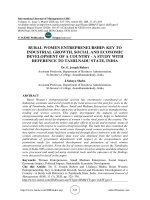Economic growth and economic development 76
Bạn đang xem bản rút gọn của tài liệu. Xem và tải ngay bản đầy đủ của tài liệu tại đây (153.05 KB, 1 trang )
Introduction to Modern Economic Growth
where x (t) ∈ Rn and G : Rn → Rn . Let x∗ be a fixed point of the mapping G (·),
i.e.,
x∗ = G (x∗ ) .
Such a x∗ is sometimes referred to as “an equilibrium point” of the difference equation (2.23). Since in economics, equilibrium has a different meaning, we will refer
to x∗ as a stationary point or a steady state of (2.23). We will often make use of
the stability properties of the steady states of systems of difference equations. The
relevant notion of stability is introduced in the next definition.
Definition 2.4. A steady state x∗ is (locally) asymptotically stable if there
exists an open set B (x∗ ) 3 x∗ such that for any solution {x (t)}∞
t=0 to (2.23) with
x (0) ∈ B (x∗ ), we have x (t) → x∗ . Moreover, x∗ is globally asymptotically stable
∗
if for all x (0) ∈ Rn , for any solution {x (t)}∞
t=0 , we have x (t) → x .
The next theorem provides the main results on the stability properties of systems
of linear difference equations. The Mathematical Appendix contains an overview of
eigenvalues and some other properties of difference equations.
Theorem 2.2. Consider the following linear difference equation system
(2.24)
x (t + 1) = Ax (t) + b
with initial value x (0), where x (t) ∈ Rn for all t, A is an n × n matrix and b is a
n × 1 column vector. Let x∗ be the steady state of the difference equation given by
Ax∗ + b = x∗ . Suppose that all of the eigenvalues of A are strictly inside the unit
circle in the complex plane. Then the steady state of the difference equation (2.24),
x∗ , is globally asymptotically stable, in the sense that starting from any x (0) ∈ Rn ,
∗
the unique solution {x (t)}∞
t=0 satisfies x (t) → x .
Proof. See Luenberger (1979, Chapter 5, Theorem 1).
Ô
Next let us return to the nonlinear autonomous system (2.23). Unfortunately,
much less can be said about nonlinear systems, but the following is a standard local
stability result.
62









